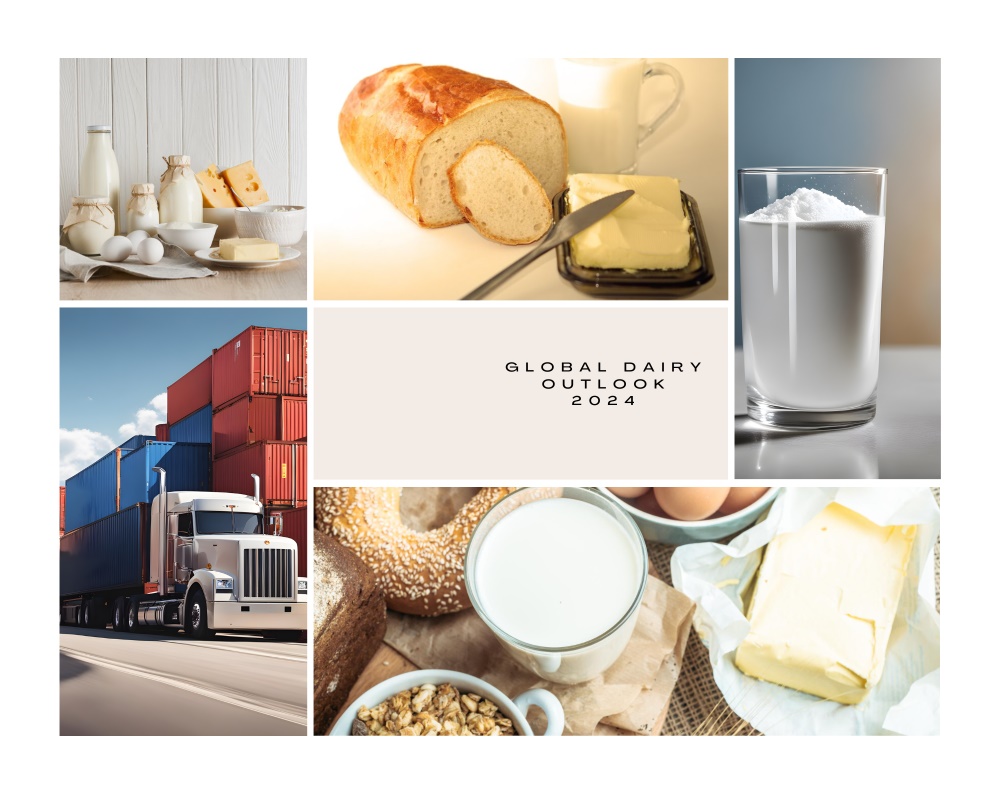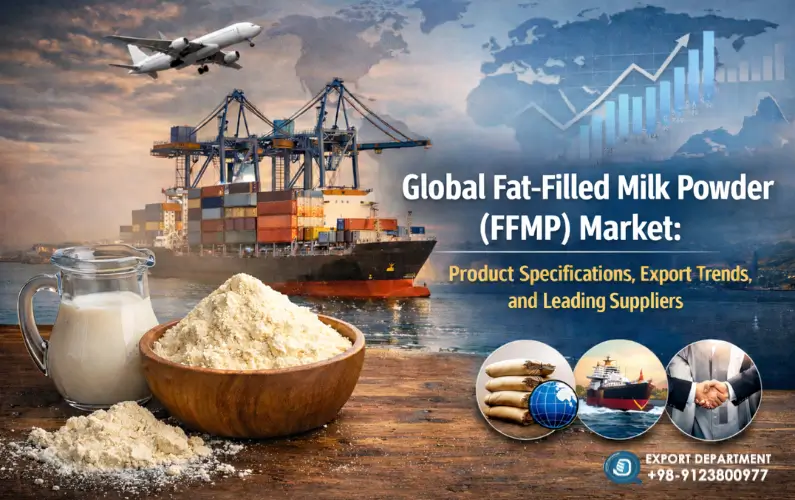Navigating Global Dairy and Milk Powder Export Markets
This article provides a comprehensive analysis of current trends, challenges, and future outlook in the global dairy market, focusing on milk and powdered dairy products, along with an examination of international prices. It highlights key players, export dynamics, market forecasts, consumption patterns, and international trade influences.
| Table of Contents |
| 1. The global dairy products export market |
| 2. Estimated Value of Global Dairy Market in 2022 and Projections for 2028 |
| 3. Leading Global Cow Milk Producer in 2023 |
| 4. Key Players in Global Skimmed Milk Powder Export Market |
| 5. Rise of Iran as a Global Player in Powdered Milk Export |
| 6. Confronting Challenges in the Global Dairy Market in 2023 |
| 7. Global Dairy Outlook 2024: Market Trends and Price Forecasts |
| 8. Outlook on Global Dairy Production and Consumption for the Next Decade |
| 9. Regional Variations in Processed Dairy Consumption |
| 10. FAQ's |
The global dairy products export market
Dairy products, especially milk in various forms, serve not only as a fundamental part of our diets but also as a valuable commodity in the realm of international trade.
The history of dairy consumption dates back over six millennia, and in the contemporary era, dairy products have become integral to the diets of people globally. Over the last two thousand years, there has been remarkable ingenuity and progress in the processing, fermentation, and consumption of dairy items.
New Zealand stands out as a leader in the global dairy industry, renowned for high-quality products like milk powder, butter, and cheese. The European Union (EU) plays a significant role, collectively exporting diverse dairy products, with notable contributions from countries such as Germany, France, and the Netherlands. The United States, a key player in the international market, exports various dairy products, including cheese, milk powder, and butter. Australia is acknowledged for its high-quality dairy exports, employing modern farming techniques to produce items like milk powder, cheese, and butter. Belarus has been steadily increasing its dairy exports, focusing on markets in Russia and neighboring countries, particularly exporting industrial milk powder and other dairy products.
Argentina, blessed with vast pastures and favorable climatic conditions, stands as a major exporter of dairy products, especially milk powder and cheese. Uruguay is also active in dairy exports, emphasizing products like milk powder and cheese, and is expanding its presence in international markets. India is emerging as a notable player in the global dairy market, exporting products like skimmed milk powder and dairy ingredients, showcasing a blend of traditional and modern farming practices.
Brazil, with a well-developed dairy industry, exports various products like milk powder and cheese, making its mark in the global dairy trade. Canada, renowned for dairy exports, particularly cheese, is distinguished for its quality and craftsmanship, making a significant contribution to the country's agricultural export industry.
Estimated Value of Global Dairy Market in 2022 and Projections for 2028
As of 2022, the global dairy market had an estimated value of around 893 billion U.S. dollars, with projections indicating growth to reach 1,243 billion dollars by 2028.
A significant outcome of globalization is the widespread consumption of dairy products, with substantial amounts of milk, cheese, and other dairy items traded between nations annually. In 2022, the total value of dairy product exports reached just under 67.95 billion U.S. dollars, a substantial increase from approximately 39.83 billion dollars in 2015. Specifically, in 2022, the global dairy product export market reached an estimated value of around 68 billion U.S. dollars, representing a modest increase from the previous year's figure of approximately 66.56 billion dollars.
The European Union, featuring nations like France, Ireland, and Germany known for their cheese and butter, dominates the global dairy product export market, commanding a 39 percent share—the largest among all world regions. Germany, as a notable contributor, independently exports about six billion dollars worth of cheese annually. Notably, New Zealand emerged as the leading global milk exporter in 2022, with an export value of 7.8 billion U.S. dollars, closely followed by Germany, with milk exports amounting to 3.5 billion dollars during the same year.
Leading Global Cow Milk Producer in 2023
In 2023, the European Union emerged as the top global producer of cow milk, with its 27 member countries collectively yielding over 143 million metric tons. The United States secured the second position, with a production volume of approximately 104 million metric tons during the same period.
Key Players in Global Skimmed Milk Powder Export Market
Non-fat dry milk, commonly known as skimmed milk powder (SMP), holds a prominent position as one of the most widely favored dairy products globally. Notable contributors to the export of SMP include China, New Zealand, the European Union, the USA, Australia, and Argentina. These nations, characterized by robust dairy industries, play a crucial role in meeting the substantial global demand for skimmed milk powder by exporting significant volumes.
Rise of Iran as a Global Player in Powdered Milk Export
Throughout its history, Iran has grappled with meeting the domestic demand for dairy products, notably powdered milk. The surge in demand can be attributed to factors such as population growth, urbanization, and evolving food preferences. Historically reliant on imported powdered milk to bridge the supply-demand gap, Iran has recently implemented strategic measures to bolster its domestic dairy production, aiming to diminish dependence on external sources.
The Iranian government has introduced a range of policies to fortify the dairy industry, with a focus on enhancing infrastructure and investing in research and development. These initiatives have borne fruit, propelling Iran towards increased milk production and elevated quality standards in dairy products. Consequently, Iran has transitioned from being a net importer to becoming an exporter of powdered milk.
This shift in Iran's dairy landscape signifies a positive development for the agricultural sector. The move towards self-sufficiency not only fortifies domestic production but also opens avenues for income generation through exports. Iran's foray into exporting milk powder showcases its competitive advantage in the global dairy industry, fostering an expanded presence in international markets.
An ex-member of the Dairy Industry Association's Board of Directors attributes Iran's leadership in dairy exports to a decline in per capita milk consumption domestically and a concurrent rise in the export share of these products. The export share of milk has surged from 10% of the country's milk production to an impressive 25%, indicating substantial growth in exports.
Chaltafarm dairy export department has experience in exporting industrial powdered milk and dairy products with the monthly production of more than 1500 tons of milk powder and more than 400 tons of butter to various markets including the Middle East, Africa, and CIS countries under Chaltafarm and Shiraland brands.
In the years 1400 and 1401, Iran engaged in substantial exports of powdered milk products (Irani Milk Powder-MP) to various countries worldwide. Importing nations encompass Syria, Lebanon, Nigeria (Africa region), Georgia, Armenia, Uzbekistan, Tajikistan, Kazakhstan, Azerbaijan, Turkmenistan (Eurasia region), Turkey (EU region), United Arab Emirates, Kuwait, Oman, Qatar (GCC region), Pakistan, Iraq, and Afghanistan. Notably, the highest export volume in 1400 to Pakistan reached 40,250 tons, marking a 24% increase to 53,000 tons in 1401, while Nigeria recorded the lowest export in 1401.
Confronting Challenges in the Global Dairy Market in 2023
In the last quarter of 2023, the global dairy market encountered difficulties marked by a constrained influx of new milk supply and sluggish demand. The industry witnessed soft pricing in global dairy commodities, primarily attributed to weakened underlying fundamentals, including subdued growth in milk supply, heightened costs, and disruptions caused by adverse weather conditions.
Throughout 2023, the global dairy sector grappled with substantial price reductions, impacting the revenues of major players like Fonterra and Saputo. Despite some stability in dairy product volumes, the downturn failed to offset the significant price decline, especially affecting European markets due to escalating inflationary pressures. This downturn resulted in diminished revenues, prompting significant industry players to reevaluate their plans. Fluctuations in milk prices and escalating raw material expenses further tightened profit margins, exemplified by FrieslandCampina's operational margin plummeting from 5% to 0.7% from H1 2022 to H1 2023. Looking forward, the industry foresees adapting to the EU's 'Farm to Fork' strategy. Furthermore, European dairy companies are reconsidering their strategies, pivoting towards diversification and seeking growth in new territories beyond traditional markets.
Global Dairy Outlook 2024: Market Trends and Price Forecasts
As 2023 concludes, there are signs that the bottom in dairy commodity markets has passed, and prices are expected to move higher in 2024. Milk supply growth is expected to be sluggish in most export regions, with inventory levels staying comfortably balanced.
The demand outlook for 2024 is crucial, influenced by factors such as high dairy inflation, broader cost-of-living concerns, and weakened consumer confidence impacting volumes in various economies and channels. Although demand conditions are improving, lingering market uncertainty persists due to rising unemployment in specific economies.
The forecast predicts that China’s import demand for dairy commodities will potentially propel a rally in Oceania commodity prices in 2024. Rabobank anticipates China’s import volume to stabilize, providing an opportunity for non-Chinese importers to build stocks. While prices are gradually rising, there is no immediate urgency to secure coverage based on current demand signals. China remains a pivotal player in the global dairy markets as the largest importer, with an estimated annual import deficit of 11.9 million metric tons of liquid milk equivalent in 2023.

Rabobank foresees a gradual recovery in commodity prices towards long-term averages, but the current fundamentals establish conditions for price volatility and potential market upheaval. Global markets, including the dairy sector, confront elevated levels of risk and uncertainty due to geopolitical instability, volatile energy markets, and feeble macroeconomic conditions, making 2024 a pivotal year for the dairy industry and the broader food system.
The onset of 2024 has seen a positive start for global dairy prices, evidenced by the first fortnightly Global Dairy Trade (GDT) auction of the year, where the GDT price index rose by 1.2% to an average price of US$3,363 per ton.
The dairy market is undergoing a transition to the next phase of its cycle, with prices expected to rise throughout 2024. However, the market remains delicately poised, and underlying demand for the year continues to pose uncertainties. Rabobank projects a modest growth forecast for milk supply in 2024.
To conclude, Several factors will influence dairy prices in 2024, including the impact of cost reductions and diminishing milk production yields, farmgate milk prices, and the potential for market volatility stemming from geopolitical instability, volatile energy markets, and weak macroeconomic conditions. Demand trends, especially in China, consumer confidence, inflation impact, and global market intricacies, are also identified as critical factors to monitor in the approaching year.
Outlook on Global Dairy Production and Consumption for the Next Decade
Over the next decade, it is projected that India and Pakistan, significant milk producers, will contribute over half of the world’s milk production growth and will represent more than 30% of global production by 2030. Meanwhile, the European Union, the second largest global milk producer, is anticipated to experience slower production growth compared to the world average due to policies promoting sustainable production and sluggish domestic demand growth.
The majority of dairy production is consumed in the form of fresh dairy products, which are either unprocessed or minimally processed (e.g., pasteurized or fermented). The share of fresh dairy products in global consumption is expected to rise over the next decade, driven by robust demand growth in India, Pakistan, and Africa, stemming from increases in income and population. In developed nations, per capita consumption is forecasted to moderately increase to 25.2 kg (milk solids) in 2030, compared to a rise to 12.6 kg in developing countries. Developed countries tend to prefer processed products, whereas fresh dairy products account for over 75% of average per capita dairy consumption in milk solids in developing countries.
Regional Variations in Processed Dairy Consumption
The consumption of processed dairy products varies significantly by region. Cheese, the second most important dairy product consumed in terms of milk solids after fresh dairy products, is primarily consumed in Europe and North America and is experiencing growth in both regions. In Asia, butter is the most consumed processed dairy product, representing nearly half of all processed dairy consumption in terms of milk solids. Butter also shows the most robust projected growth in consumption, albeit starting from a lower base compared with Europe and North America. In Africa, cheese and whole milk powder (WMP) constitute the majority of processed dairy consumption in milk solids. However, over the next decade, skimmed milk powder (SMP) is anticipated to exhibit the highest growth, albeit from a lower consumption base.
FAQ's
What is the estimated value of the global dairy market in 2022 and the projections for 2028?
As of 2022, the estimated value of the global dairy market was around 893 billion U.S. dollars, with projections indicating growth to reach 1,243 billion dollars by 2028.
Who are the leading global cow milk producers in 2023?
In 2023, the European Union emerged as the top global producer of cow milk, with the United States securing the second position in terms of production volume.
Which countries are the key players in the global skimmed milk powder export market?
China, New Zealand, the European Union, the USA, Australia, and Argentina are key players in the global skimmed milk powder export market.
How has Iran emerged as a global player in powdered milk export?
Iran has transitioned from being a net importer to becoming an exporter of powdered milk by implementing strategic measures to bolster its domestic dairy production, enhancing infrastructure, and investing in research and development.
What were the challenges faced by the global dairy market in 2023?
In 2023, the global dairy market encountered difficulties marked by a constrained influx of new milk supply and sluggish demand, resulting in soft pricing in global dairy commodities.
What are the market trends and price forecasts for global dairy products in 2024?
The forecast suggests that the bottom in dairy commodity markets has passed, and prices are expected to move higher in 2024. The demand outlook for 2024 is influenced by factors such as high dairy inflation, broader cost-of-living concerns, and weakened consumer confidence impacting volumes in various economies and channels.
What are the outlooks on global dairy production and consumption for the next decade?
India and Pakistan are projected to contribute over half of the world’s milk production growth and represent more than 30% of global production by 2030, while the European Union’s production growth is anticipated to be slower due to policies promoting sustainable production and sluggish domestic demand growth.
Read More:2024 Insights on Dairy and Milk Powder Prices, Exports, and Trade Flows
Read More: Insights into Different Types of Butter: Exploring the World of Butter
To contact the Chaltafarm Dairy Export Department, please refer to the Contact Us section.
Ref:
[1] www.dairyglobal.net/
[2] www.business-standard.com/
[3] https://research.rabobank.com/
[4] www.interfood.com

.svg)

.webp)

.webp)
